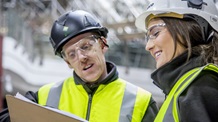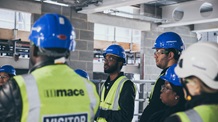Perspectives
Appealing to Gen Z – the industry’s 4 areas of focus
Just when we were all getting to grips with how the workplace can support millennials, the next generation arrives. Generation Z (born 1996 – 2015) are now fully embedded within the workforce, and they are more sure of what they want and what they need to succeed than any that have come before. That’s why it is now on us as an industry to ensure that we attract, develop and retain this latest generation - to secure our future-fit workforce.
According to the Construction Industry Council, age profiles mean that the sector could be without a quarter of its workforce within the next 10-15 years. Yet in Gen Z, we now have a cluster of talent closely aligned to the key agendas our industry urgently needs to address.The influx of the millennial generation paved the way for the built environment’s collaborative, open plan offices, flexible working patterns and creative design. Gen Z are set to have a similarly transformative effect - they currently make up 30 percent of the world's population and are expected to account for 27 percent of the workforce by 2025. Having grown up during the 2007 recession, with technology at their fingertips since birth and battling through COVID-19 during formative years, they are a generation driven by a range of unique motivations. But what are those drivers and how can the built environment work harder to address them?
1. Giving back
Twenty-six per cent of 16 to 19-year-olds currently volunteer, and 76% are concerned about humanity's impact on the planet. So when it comes to a career path, 60% of Gen Z want their jobs to have a positive impact. They want careers that allow them to do good, improve the lives of communities and benefit the planet. It is on us as an industry to demonstrate the difference that can be made working within the built environment, from the actions we are taking to combat climate change, to the support and infrastructure we are developing for less fortunate communities.
With 62% of Gen Z saying they trust companies that demonstrate social responsibility, versus just 56% of millennials, establishing how your company is making a difference to people’s lives, and enabling the workforce to be part of it, will catch the interest of young workers, whose passion can then too drive further positive change.
2. Healthy minds
Gen Z expect a working environment to provide some, if not all, of today’s advancements in health and wellbeing. Ergonomic furniture with sit-to-stand desks, outdoor spaces and live plants to improve indoor air quality are some of the staples. However, coming of age in a time of political and economic unrest, Gen Z employees have been found to prioritize their mental health over everything else. According to a recent U.S. survey, 82% of surveyed respondents advocated for annual mental health days.
And while mandated days are effective, the built environment should be ensuring that rest and recovery is hard-wired into the way we as an industry function. It’s vital that rest and recovery is made a milestone and programmed into delivery plans and project and change programmes. Data is a key aspect of this, ensuring that we are recording, reporting on and reviewing hours worked, analysing survey trends, absence trends and annual leave uptake. All of this helps to normalise what should become an industry-wide culture of rest and recovery.
3. A workplace of inclusion
Gen Z is the most diverse population in both UK and US history, and 76% rank diversity and inclusivity in a company as important. It makes sense - diverse people want to work for diverse companies. Therefore, the industry approach to inclusion must be focused on drawing from the richness of our differences. The built environment has recently made great strides on diversity but the fact remains that in the UK alone, just 5.4% of construction workers are from a black, Asian or ethnic minority background. And while women account for just under half of the total UK workforce, they make up only 11 per cent of the construction workforce and just 1 per cent of workers on site.
From mandatory diversity training to policy shifts, there’s both much more to be and being done in tackling this issue. My colleagues in the Pride at Mace network explored possible ways forward in a recent perspective here.
4. Working on the cutting edge
World Skills UK reported that 88 per cent of young people (aged 16-24) view digital skills as essential for their careers. It’s a synergy that is shared with the built environment, with digital technology rapidly transforming our industry. Yet just 31% thirty-one percent of Gen Z were aware the industry is a place they can develop digital skills.
From our work with robotics to the implementation of VR, to attract a generation of digital natives, the cutting-edge opportunities that the built environment offers needs to be promoted and conveyed correctly. 2021 saw a record number of students arrive at university, meaning that to truly appeal to this generation, collaborating with educational bodies in way we advertise will play a vital role in the built environment’s efforts to recruit a young workforce.
One size is not going to fit all, and with millennials and Generation X still dominating the workplace for years to come, any workplace strategy also needs to get the balance right and positively bring different generations together. Creating workplace solutions that offer greater face-to-face collaboration, voices to be heard, and communication to be instant, direct and two way, will ensure you get the most out of your latest recruits without alienating employees that have remained loyal to your company for decades. Recognising the importance of encouraging individuality, for zones or areas to cater for different needs and for different generations to collaborate and communicate, will ultimately benefit our industry both now and in the future.











